Background
The Extent
History
Nations
People
Society
Gaming
Technology
General Technology
Military Technology
War World
History
1876-1879 (The Society)
 "The Society" appeared in the latter half of the 19th Century and, over the next five decades, fed the world new scientific theories, philosophies and other ideas doing so without prejudice or favour... by the end of the nineteenth century, various nations had launched one or more permanently orbiting satellites. Twenty years later, with the launch of the first ever generation ship and the rush of similar ships that followed, humanity finally became a truly spacefaring race.
"The Society" appeared in the latter half of the 19th Century and, over the next five decades, fed the world new scientific theories, philosophies and other ideas doing so without prejudice or favour... by the end of the nineteenth century, various nations had launched one or more permanently orbiting satellites. Twenty years later, with the launch of the first ever generation ship and the rush of similar ships that followed, humanity finally became a truly spacefaring race.
2200-2699 (The Hypergate Network)
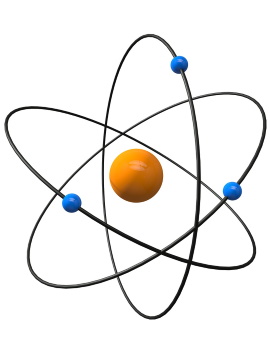 A group based at Greenwich confirmed the existence of alternate dimensions and eventually demonstrated their use for rapid transit to other star systems. The discovery led to the creation of a network of gates allowing ships to move instantaneously between linked areas of space. By the start of the twenty-third century, most systems were networked and humanity called its domain, The Extent.
A group based at Greenwich confirmed the existence of alternate dimensions and eventually demonstrated their use for rapid transit to other star systems. The discovery led to the creation of a network of gates allowing ships to move instantaneously between linked areas of space. By the start of the twenty-third century, most systems were networked and humanity called its domain, The Extent.
2700-2749 (The Amaranthine War)
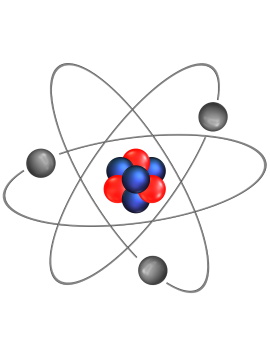 As war erupts between The Kochevnik and the Akatsu, the UCS adopt Port McKinley as a forward base. Kaya Ishimori created Akatsu's secretive Bunrui Jigyōbu. The Skean designed new robots designed to identify and destroy enemy units efficiently as the UCS entered the war with fast and rapidly-acting armoured infantry. The Skean reorganised their military into a single cohesive organisation as the co-developed "Corvettes", small, fast, lightly armoured but well-armed ships, designed to down hunt cruise-bombers.
As war erupts between The Kochevnik and the Akatsu, the UCS adopt Port McKinley as a forward base. Kaya Ishimori created Akatsu's secretive Bunrui Jigyōbu. The Skean designed new robots designed to identify and destroy enemy units efficiently as the UCS entered the war with fast and rapidly-acting armoured infantry. The Skean reorganised their military into a single cohesive organisation as the co-developed "Corvettes", small, fast, lightly armoured but well-armed ships, designed to down hunt cruise-bombers.
2700-2749 (The Amaranthine War)
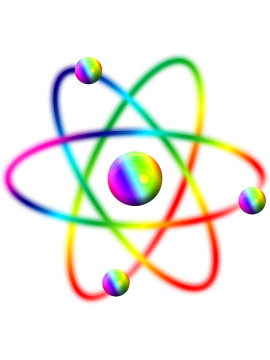 The first true machine intelligence was built and work was begun to upgrade Port McKinley's defence platforms as Emperor Ishimori was elevated to Imperial Warlord. The Akatsu invaded the Qing system as a terrorist act gave Kaiser the Geist Democratic Authority. Against a background of Kaiser proclaiming his empire would last ten thousand years, Empress Augusta was formally crowned and both Kaiser and Ferraro called for more living space.
The first true machine intelligence was built and work was begun to upgrade Port McKinley's defence platforms as Emperor Ishimori was elevated to Imperial Warlord. The Akatsu invaded the Qing system as a terrorist act gave Kaiser the Geist Democratic Authority. Against a background of Kaiser proclaiming his empire would last ten thousand years, Empress Augusta was formally crowned and both Kaiser and Ferraro called for more living space.
2786-2793 (The Simerian-Lacuna War)
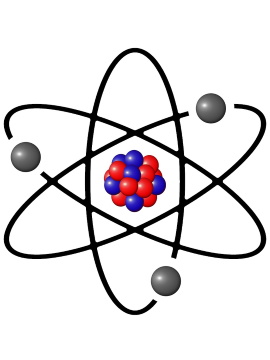 Lawrence declared war against the Geist as the "Allies" developed new technologies and tactics. The UCS stayed neutral but relaxed arms restrictions to the Skean and LaVie and The Geist Battlecruiser, GKV Maxim, was scuttled. In late 2792, Skean forces attacked the Valentian base on Vulcan whilst, in the Sea of Souls, much of the Valentian fleet was destroyed. The latest ultra-plasma drive test was successful, the new engines becoming a priority for all new military ships. In 2793, the Akatsu invaded the Chinthe and Âu Cơ systems resulting in significant deterioration of relations with the UCS.
Lawrence declared war against the Geist as the "Allies" developed new technologies and tactics. The UCS stayed neutral but relaxed arms restrictions to the Skean and LaVie and The Geist Battlecruiser, GKV Maxim, was scuttled. In late 2792, Skean forces attacked the Valentian base on Vulcan whilst, in the Sea of Souls, much of the Valentian fleet was destroyed. The latest ultra-plasma drive test was successful, the new engines becoming a priority for all new military ships. In 2793, the Akatsu invaded the Chinthe and Âu Cơ systems resulting in significant deterioration of relations with the UCS.
United Colonial Systems
 The United Colonial Systems or UCS are a group of planets that have merged into one nation and the Star and Crescent Moon banner. The alliance has expanded recently with the addition of the Ice System, Isthma and, most recently, Aumakua bringing the total number of planets to twenty-two across twelve distinct systems.
The United Colonial Systems or UCS are a group of planets that have merged into one nation and the Star and Crescent Moon banner. The alliance has expanded recently with the addition of the Ice System, Isthma and, most recently, Aumakua bringing the total number of planets to twenty-two across twelve distinct systems.
The Ascendancy of Dawn
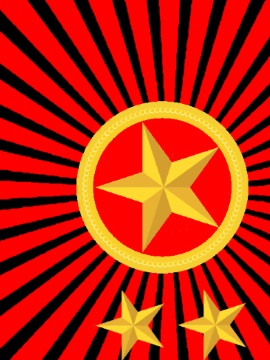 The Akatsu, physically distant ally of The Geist and Valentians, hail from a trinary star system once known as Rigil Kentaurus. Akatsu is the primary star and hosts the inhabited planets, Hiroshi and Hayashi whose inhabitants call their primary "The Daylight Sun", its Akatsu name literally translating to "Dawn". Hiroshi is an ocean covered world with less than twelve percent land surface and is home to the Emperor's Palace and The Extent's first floating city, Yori. The Akatsu have been expanding in recent decades, primarily into Tayjekan territory. Akatsu, reliant on imports to drive their increasingly mechanised economy, have recently been expanding into Zuìzhōng territory.
The Akatsu, physically distant ally of The Geist and Valentians, hail from a trinary star system once known as Rigil Kentaurus. Akatsu is the primary star and hosts the inhabited planets, Hiroshi and Hayashi whose inhabitants call their primary "The Daylight Sun", its Akatsu name literally translating to "Dawn". Hiroshi is an ocean covered world with less than twelve percent land surface and is home to the Emperor's Palace and The Extent's first floating city, Yori. The Akatsu have been expanding in recent decades, primarily into Tayjekan territory. Akatsu, reliant on imports to drive their increasingly mechanised economy, have recently been expanding into Zuìzhōng territory.
The Skean Republic
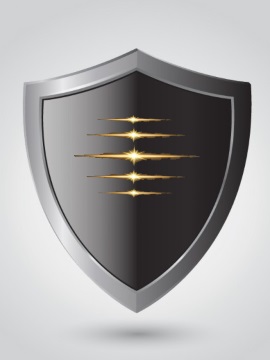 The Solar System, the birthplace of humanity and the ancestral home of every human across known space, has more populated planets and moons than any other system. More than half the human race still live on Earth and a further ten percent are spread throughout the system. Sol's people, the moon included, are a homogeneous mix of racial and national types but most of the colonised planets and moons have specific racial or national biases.
The Solar System, the birthplace of humanity and the ancestral home of every human across known space, has more populated planets and moons than any other system. More than half the human race still live on Earth and a further ten percent are spread throughout the system. Sol's people, the moon included, are a homogeneous mix of racial and national types but most of the colonised planets and moons have specific racial or national biases.
Kurt Bergstrom
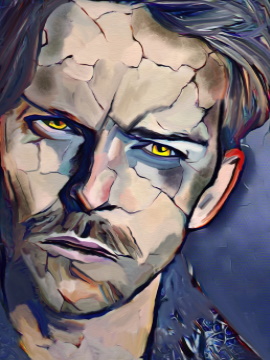 A twenty-nine-year-old Marine Officer who prefers to be called Kurt rather than his first birth name, Eric. He is a specialist working for the Special Naval Intelligence Service based at Port McKinley but he currently calls Enlightenment, New Liberty (New Liberty) his home. He comes from a family that holds its Swedish ancestry proudly. McKinley's new Port Admiral believes Bergstrom has served superbly during the continuing Abyssal Void War and understand that he has no plans to leave the military at present. Despite the danger, Bergstrom enjoys his work, finding it challenging but rewarding.
A twenty-nine-year-old Marine Officer who prefers to be called Kurt rather than his first birth name, Eric. He is a specialist working for the Special Naval Intelligence Service based at Port McKinley but he currently calls Enlightenment, New Liberty (New Liberty) his home. He comes from a family that holds its Swedish ancestry proudly. McKinley's new Port Admiral believes Bergstrom has served superbly during the continuing Abyssal Void War and understand that he has no plans to leave the military at present. Despite the danger, Bergstrom enjoys his work, finding it challenging but rewarding.
Kiyo Matsuyama
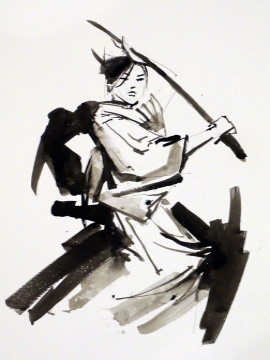 Kiyo Matsuyama ("Kiki") is a thirty-year-old, Bunrui Jigyōbu specialist and, to society in general, a wealthy socialite. She is something of a loner and, with one exception, despite having an excellent working relationship with those in her team, has relatively few friends and she rarely socialises with work colleagues. Her closest friend is ten-year-old Jira who lives with her and was her partner during her days as an assassin. Jira, her companion and constant protector, is a genetically modified animal derived from Panthera onca stock.
Kiyo Matsuyama ("Kiki") is a thirty-year-old, Bunrui Jigyōbu specialist and, to society in general, a wealthy socialite. She is something of a loner and, with one exception, despite having an excellent working relationship with those in her team, has relatively few friends and she rarely socialises with work colleagues. Her closest friend is ten-year-old Jira who lives with her and was her partner during her days as an assassin. Jira, her companion and constant protector, is a genetically modified animal derived from Panthera onca stock.
Ariel Weinberg
 Ariel Weinberg is a thirty-year-old UCS officer born on Fulcrum in the Lucille system. Olive skinned with short brown hair she tends to dress casually tomboyish during downtime. She is Kurt Bergstrom's best friend and confidant and is of lesbian sexual orientation.
Ariel Weinberg is a thirty-year-old UCS officer born on Fulcrum in the Lucille system. Olive skinned with short brown hair she tends to dress casually tomboyish during downtime. She is Kurt Bergstrom's best friend and confidant and is of lesbian sexual orientation.
Kiya Matsuyama
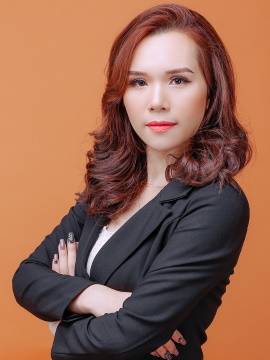 The late Kiya Utsubo-Matsuyama was one of Hiroshi's most famous entrepreneurs, having helped build the City of Yori, the first floating city in the extent. Born on Hattori in 2715, her parents moved to Hiroshi because to support her education. University educated to PhD level in Economics, she started Utsubo-Akio Inc. with her friend, Leia Akio. They were extremely successful rising up the Edo Financial Index to become one of Akatsu's top ten companies but the stress became too much for Akio and she sold her share of the company to Utsubo in 2749. Utsubo relaunched the company as Utsubo Systems Inc.
The late Kiya Utsubo-Matsuyama was one of Hiroshi's most famous entrepreneurs, having helped build the City of Yori, the first floating city in the extent. Born on Hattori in 2715, her parents moved to Hiroshi because to support her education. University educated to PhD level in Economics, she started Utsubo-Akio Inc. with her friend, Leia Akio. They were extremely successful rising up the Edo Financial Index to become one of Akatsu's top ten companies but the stress became too much for Akio and she sold her share of the company to Utsubo in 2749. Utsubo relaunched the company as Utsubo Systems Inc.
Yori Matsuyama
 The late Yori Matsuyama was an engineer and one of Hiroshi's most famous entrepreneurs, having built the City of Yori, the first floating city in the extent. He started his career working for Hiroshi Liner Outfitters where he was tasked with the disposal of an oversized liner hull, two kilometres long and one wide. Ignoring his colleagues' ridicule, he proposed the revolutionary idea of using it to create a floating community.
The late Yori Matsuyama was an engineer and one of Hiroshi's most famous entrepreneurs, having built the City of Yori, the first floating city in the extent. He started his career working for Hiroshi Liner Outfitters where he was tasked with the disposal of an oversized liner hull, two kilometres long and one wide. Ignoring his colleagues' ridicule, he proposed the revolutionary idea of using it to create a floating community.
Vivanianism
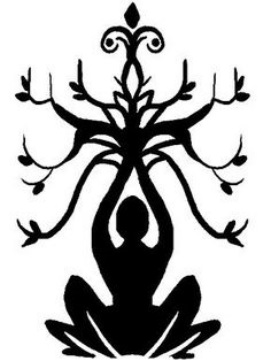 Primarily practised within the UCS sphere, the Vivanian polytheistic religion revolves around the overarching god of life, Vivanus, and her siblings, the four elementals, Terranus, Neronia, Anemos and Pyranium. Like the majority of religions births, deaths, adulthood and marriage are celebrated though the latter usually only when a couple enter the third stage. Each of the elementals has their own holy week but Vivanus's, Festival of the Holy Mother, the overarching god of life, runs from the last day of the year and lasts two weeks. The main Vivanian temple is in the Vortex system.
Primarily practised within the UCS sphere, the Vivanian polytheistic religion revolves around the overarching god of life, Vivanus, and her siblings, the four elementals, Terranus, Neronia, Anemos and Pyranium. Like the majority of religions births, deaths, adulthood and marriage are celebrated though the latter usually only when a couple enter the third stage. Each of the elementals has their own holy week but Vivanus's, Festival of the Holy Mother, the overarching god of life, runs from the last day of the year and lasts two weeks. The main Vivanian temple is in the Vortex system.
Kami-no-Michi
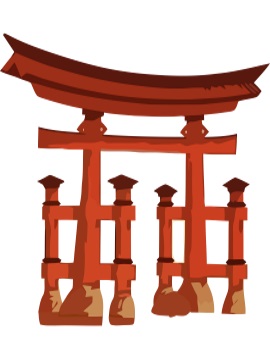 Kami-no-Michi translates as "The Way of the Gods" and is the largest Akatsu religion practised across The Extent. It traces its roots back through its Shinto parentage to ancient Japan, establishing the Akatsu Imperial family as direct descendants of Amaterasu and the foundation of Akatsu culture. Like Shinto, there are various cults and it is deeply wrapped in tradition.
Kami-no-Michi translates as "The Way of the Gods" and is the largest Akatsu religion practised across The Extent. It traces its roots back through its Shinto parentage to ancient Japan, establishing the Akatsu Imperial family as direct descendants of Amaterasu and the foundation of Akatsu culture. Like Shinto, there are various cults and it is deeply wrapped in tradition.
New Christianity
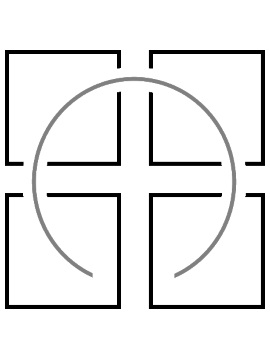 New Christianity is a monotheistic religion based on around the teachings of a book known as The Bible and, more specifically their Messiah, Christos. It is one of the largest religions practised across The Extent with over two billion followers, approximately the same as Islam. The New Christian holy book of scriptures is called The Bible which is split into two sections, the Old Earth and New Extent testaments with the coming of the New Christian Messiah prophesised in The Old and confirmed in The New.
New Christianity is a monotheistic religion based on around the teachings of a book known as The Bible and, more specifically their Messiah, Christos. It is one of the largest religions practised across The Extent with over two billion followers, approximately the same as Islam. The New Christian holy book of scriptures is called The Bible which is split into two sections, the Old Earth and New Extent testaments with the coming of the New Christian Messiah prophesised in The Old and confirmed in The New.
Buddhism
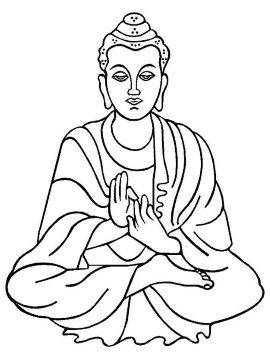 Largely unchanged from its Earthly roots over three thousand years ago, Buddhism, with nearly half a billion followers across The Extent, means to "Awaken" or become "Enlightened". To many of its followers, Buddhism is more of a philosophy than a religion. Many Buddhists consider themselves to be seekers of truth or knowledge. To them, the faith helps them lead a more moral life, to be mindful of their thoughts and actions as well as develop wisdom and a deeper understanding of the human place in the galaxy. As a result, Buddhists tend to peacefully coexist with believers of other religions and some AIs have embraced the philosophy as one by which they can live.
Largely unchanged from its Earthly roots over three thousand years ago, Buddhism, with nearly half a billion followers across The Extent, means to "Awaken" or become "Enlightened". To many of its followers, Buddhism is more of a philosophy than a religion. Many Buddhists consider themselves to be seekers of truth or knowledge. To them, the faith helps them lead a more moral life, to be mindful of their thoughts and actions as well as develop wisdom and a deeper understanding of the human place in the galaxy. As a result, Buddhists tend to peacefully coexist with believers of other religions and some AIs have embraced the philosophy as one by which they can live.
N'Chari
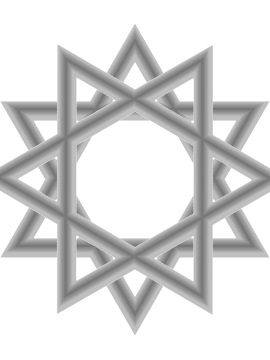 Like most religions, the N'Chari religion is a philosophy but unlike many others, it is also a culture and a way of life. In other words, N'Chari describes both the N'Chari who is of the N'Chari culture so it is entirely possible to be an N'Chari atheist i.e. a nonbeliever who is culturally N'Chari. The belief, a spinoff of Judaism, is monotheistic and it is part of the faith that its followers have a true relationship, a covenant with their god describing themselves as The Children of N'Chari.
Like most religions, the N'Chari religion is a philosophy but unlike many others, it is also a culture and a way of life. In other words, N'Chari describes both the N'Chari who is of the N'Chari culture so it is entirely possible to be an N'Chari atheist i.e. a nonbeliever who is culturally N'Chari. The belief, a spinoff of Judaism, is monotheistic and it is part of the faith that its followers have a true relationship, a covenant with their god describing themselves as The Children of N'Chari.
Guilds
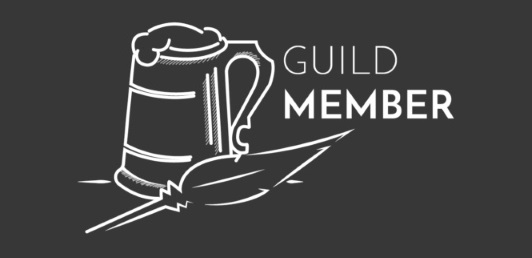 Guilds are groups of people that band together for common cause and are a development of the Solar Unions, a means to help each other and resist company management but, over time, developing a wider support system. Most are secretive and the most notorious example is The Assassins Guild, an organisation of trained killers that live by the simple rule, "Assassins kill, get killed but don't talk." Membership of The Assassins Guild protects assassins on "legitimate" missions ensuring the commissioning party is held responsible for all actions taken in their name. Guild membership is banned across the Extent militaries and the Kochevnik nations.
Guilds are groups of people that band together for common cause and are a development of the Solar Unions, a means to help each other and resist company management but, over time, developing a wider support system. Most are secretive and the most notorious example is The Assassins Guild, an organisation of trained killers that live by the simple rule, "Assassins kill, get killed but don't talk." Membership of The Assassins Guild protects assassins on "legitimate" missions ensuring the commissioning party is held responsible for all actions taken in their name. Guild membership is banned across the Extent militaries and the Kochevnik nations.
Slam Zero
 Slam Zero, in its purest form, is a zero-gravity sport played by teams of varying size (typically three, five or seven) with players wearing lightweight protective suits and helmets. Most systems will have a zero-gravity sports complex in orbit around one of their planets and Slam Zero is the most popular Extent-wide sport at present. Although lightweight, player's suits are equipped with stabilising and thrust mechanisms that allow them to move around the play area as required by the dictates of the game. The thrusters are relatively weak (mandated) so most players prefer to push off from the sides of the arena or from any static objects placed throughout the gaming area.
Slam Zero, in its purest form, is a zero-gravity sport played by teams of varying size (typically three, five or seven) with players wearing lightweight protective suits and helmets. Most systems will have a zero-gravity sports complex in orbit around one of their planets and Slam Zero is the most popular Extent-wide sport at present. Although lightweight, player's suits are equipped with stabilising and thrust mechanisms that allow them to move around the play area as required by the dictates of the game. The thrusters are relatively weak (mandated) so most players prefer to push off from the sides of the arena or from any static objects placed throughout the gaming area.
War
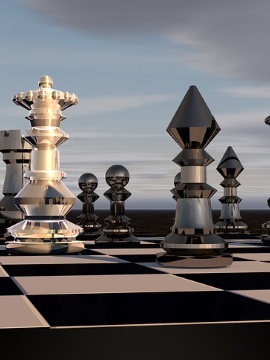 War is a four-dimensional strategy game similar to chess. It is a two-player game, with someone playing either another person or the computer and is played in a hologrammatic "arena" (the play area). There are several variants but the "War Game Society" defines the game as being based in a one-metre diameter spherical arena each with around four thousand distinct locations.
War is a four-dimensional strategy game similar to chess. It is a two-player game, with someone playing either another person or the computer and is played in a hologrammatic "arena" (the play area). There are several variants but the "War Game Society" defines the game as being based in a one-metre diameter spherical arena each with around four thousand distinct locations.
AESRA (Advanced Electrodynamic Suspension & Rapid Acceleration)
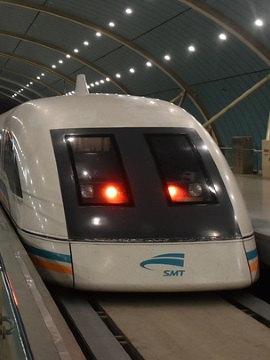 The Advanced Electrodynamic Suspension & Rapid Acceleration or AESRA is an advanced variation on electrodynamic suspension with leanings towards coil gun technology and is capable of extremely high acceleration and velocities. It has been widely adopted across The Extent enabling the automatic control of surface vehicles and cheap automated taxis, train networks, aircraft and sub-orbital vehicle launches and automated intra-system cargo shots. Excellent examples of its use are the PodNet transport systems like the extensive network built at Port McKinley. Perhaps the most significant use of AESRA technology is within the military where it is used to launch fighters and other small ships as well as the firing of kinetic weapons and other projectiles.
The Advanced Electrodynamic Suspension & Rapid Acceleration or AESRA is an advanced variation on electrodynamic suspension with leanings towards coil gun technology and is capable of extremely high acceleration and velocities. It has been widely adopted across The Extent enabling the automatic control of surface vehicles and cheap automated taxis, train networks, aircraft and sub-orbital vehicle launches and automated intra-system cargo shots. Excellent examples of its use are the PodNet transport systems like the extensive network built at Port McKinley. Perhaps the most significant use of AESRA technology is within the military where it is used to launch fighters and other small ships as well as the firing of kinetic weapons and other projectiles.
AI (Artificial Intelligence)
 Artificial intelligences are non-human intelligences based on advanced organic silicon technologies. Despite being artificial, constructed by computers and other AIs, they are fully sentient beings capable of independent thought and decision making. Amongst both researchers and manufacturers the process of awakening an AI for the first time is referred to as "birth".
Artificial intelligences are non-human intelligences based on advanced organic silicon technologies. Despite being artificial, constructed by computers and other AIs, they are fully sentient beings capable of independent thought and decision making. Amongst both researchers and manufacturers the process of awakening an AI for the first time is referred to as "birth".
Akatsu Liners
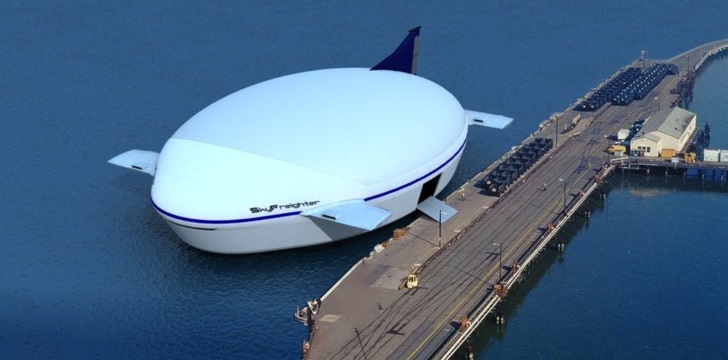 Liners were designed to deal with Hiroshi's exceptionally large water surface. They are large, light and can carry huge amounts of cargo. Built using a form of vacuum foam which hardens to form a low-density matrix, almost as light as vacuum, liners can be more than fifteen hundred metres long, five hundred metres wide and up to five hundred metres high. They use thrust-vectoring lift fans and control vanes to control movement and usually dock on the water. On Hiroshi, liners are generally considered the safest form of transport and there are cargo, passenger and military variants.
Liners were designed to deal with Hiroshi's exceptionally large water surface. They are large, light and can carry huge amounts of cargo. Built using a form of vacuum foam which hardens to form a low-density matrix, almost as light as vacuum, liners can be more than fifteen hundred metres long, five hundred metres wide and up to five hundred metres high. They use thrust-vectoring lift fans and control vanes to control movement and usually dock on the water. On Hiroshi, liners are generally considered the safest form of transport and there are cargo, passenger and military variants.
AMS (Anti-Meteor Shielding)
 A development of powered military vehicle armour which can produce a spherical or shaped electromagnetic envelope around a ship to protect it from smaller asteroids. Combined with an ultrafast, automated laser defence system to deal with intermediate sized meteoroids it is an effective way of protecting a fast-moving ship.
A development of powered military vehicle armour which can produce a spherical or shaped electromagnetic envelope around a ship to protect it from smaller asteroids. Combined with an ultrafast, automated laser defence system to deal with intermediate sized meteoroids it is an effective way of protecting a fast-moving ship.
Cloning
 In medical terms, cloning is the duplication of tissues, organs, limbs and even whole bodies for the purpose of repairing a body that has been damaged. In some cases, particularly when there is damage to complex organs such as the brain, only a part of the cloned organ is used to repair the damage.
In medical terms, cloning is the duplication of tissues, organs, limbs and even whole bodies for the purpose of repairing a body that has been damaged. In some cases, particularly when there is damage to complex organs such as the brain, only a part of the cloned organ is used to repair the damage.
Hyperspace
 Hyperspace is an alternate dimension through which it is possible to send objects. Nathan Alexander, assisted by Eiko Nakamura, at Greenwich University established the dimension's existence and formed the Alternate Dimension project. Haltingly the project progressed and, with the launch of a new Discovery class of ships, a network of gates constructed to reunite the disparate colonies.
Hyperspace is an alternate dimension through which it is possible to send objects. Nathan Alexander, assisted by Eiko Nakamura, at Greenwich University established the dimension's existence and formed the Alternate Dimension project. Haltingly the project progressed and, with the launch of a new Discovery class of ships, a network of gates constructed to reunite the disparate colonies.
Immersaline
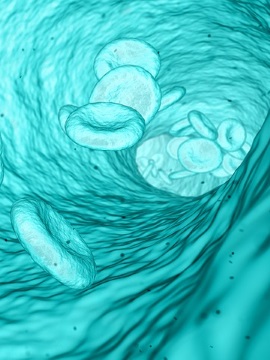 Immersaline is a light blue, organic fluid with a viscosity approximating that of human blood. In its "natural" state, it is incapable of supporting flame or allowing explosions to proceed but, under specific conditions, it can be made to carry other gasses and has a high affinity with oxygen. In use Immersaline fully immerses the subject, penetrates the body including the digestive tract and respiratory system. It is supportive and was designed to allow humans to crew ships accelerating at up to 30G as well as manoeuvre at high stress.
Immersaline is a light blue, organic fluid with a viscosity approximating that of human blood. In its "natural" state, it is incapable of supporting flame or allowing explosions to proceed but, under specific conditions, it can be made to carry other gasses and has a high affinity with oxygen. In use Immersaline fully immerses the subject, penetrates the body including the digestive tract and respiratory system. It is supportive and was designed to allow humans to crew ships accelerating at up to 30G as well as manoeuvre at high stress.
Replication
 Replication is a somewhat inaccurate name for what is basically a three-dimensional printing process carried out by nanotech enabled print devices. Using this technology, clients can print anything from paper reports and newspapers to components used to build spacecraft. It is one of the most important technologies developed since humans colonised the planets they now call "The Extent".
Replication is a somewhat inaccurate name for what is basically a three-dimensional printing process carried out by nanotech enabled print devices. Using this technology, clients can print anything from paper reports and newspapers to components used to build spacecraft. It is one of the most important technologies developed since humans colonised the planets they now call "The Extent".
Spatial Navigation
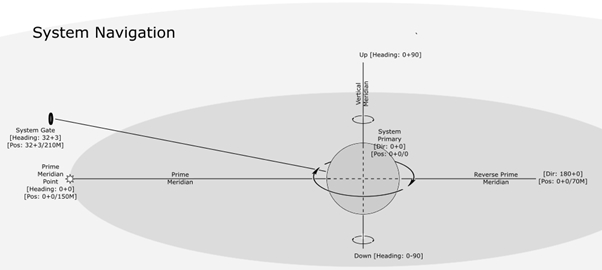 Travel through a gate, across a hyperspatial interface, is essentially instantaneous. As such, space travel, including all combat, must occur in real space and almost always within the confines of a stellar system. A system is a vast three-dimensional space and navigation within it is normally referenced with respect to that system's primary.
Travel through a gate, across a hyperspatial interface, is essentially instantaneous. As such, space travel, including all combat, must occur in real space and almost always within the confines of a stellar system. A system is a vast three-dimensional space and navigation within it is normally referenced with respect to that system's primary.
Terraforming
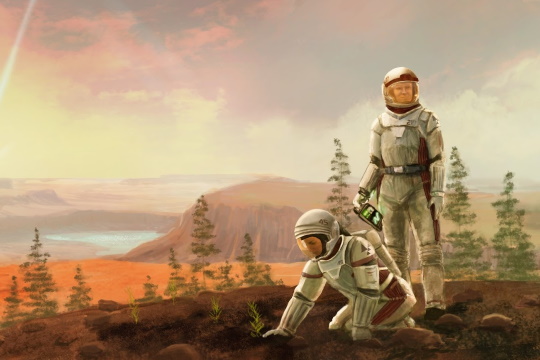 Terraforming is the process of environmentally engineering a planet or moon so that it is better suited to human habitation (more terra-like) but the process is time consuming even assuming a viable candidate is identified. There are some three hundred habitable worlds across The Extent but considerable more non-habitable, most worlds being resource worlds (mining or military) few deemed worthy of a name. Terraforming is split into 4 main phases: Candidate selection, Establishment, Terraforming and Colonisation. Once a planet is stabilised the majority of the terraformers drop into a hibernating state but in some cases, the terraforming effect needs to be maintained and the terraformers remain active to ensure the planet remains habitable.
Terraforming is the process of environmentally engineering a planet or moon so that it is better suited to human habitation (more terra-like) but the process is time consuming even assuming a viable candidate is identified. There are some three hundred habitable worlds across The Extent but considerable more non-habitable, most worlds being resource worlds (mining or military) few deemed worthy of a name. Terraforming is split into 4 main phases: Candidate selection, Establishment, Terraforming and Colonisation. Once a planet is stabilised the majority of the terraformers drop into a hibernating state but in some cases, the terraforming effect needs to be maintained and the terraformers remain active to ensure the planet remains habitable.
Armed Merchantmen
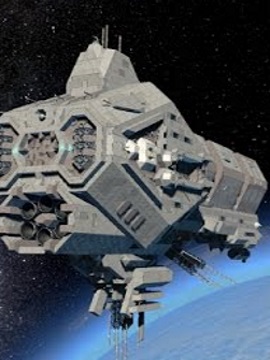 Armed merchantmen are either converted freighters or built to look like them i.e. they look and act like freighters but are "enhanced", typically faster, more heavily armoured and carrying more firepower than a typical freighter. The armed merchantman is better against pirates than against a true military force and, prior to the development of the Corvette, served as disguised protection against wolf-packs attacking the convoys they shepherded.
Armed merchantmen are either converted freighters or built to look like them i.e. they look and act like freighters but are "enhanced", typically faster, more heavily armoured and carrying more firepower than a typical freighter. The armed merchantman is better against pirates than against a true military force and, prior to the development of the Corvette, served as disguised protection against wolf-packs attacking the convoys they shepherded.
Biodegradable Ammunition
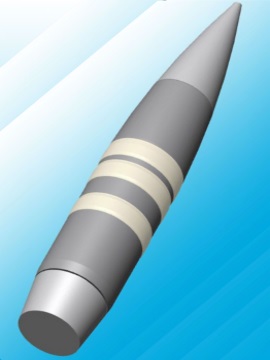 Research, following concerns raised over the time munitions took to degrade, pollution and the cost of clean-up, led to the use of biodegradable ceramoplastics in various munitions. There was a push towards assessing the projectiles of different weapon systems to see if they could be made less harmful to the environment especially since a number of manufacturers had already marketed lead-free munitions. The Assassins Guild adopted and adapted the technology to create munitions that degraded rapidly after impact leaving no easily detectable traces for forensic examination. It was, unfortunately and enthusiastically, adopted by the criminal elements in society.
Research, following concerns raised over the time munitions took to degrade, pollution and the cost of clean-up, led to the use of biodegradable ceramoplastics in various munitions. There was a push towards assessing the projectiles of different weapon systems to see if they could be made less harmful to the environment especially since a number of manufacturers had already marketed lead-free munitions. The Assassins Guild adopted and adapted the technology to create munitions that degraded rapidly after impact leaving no easily detectable traces for forensic examination. It was, unfortunately and enthusiastically, adopted by the criminal elements in society.
Flechettes
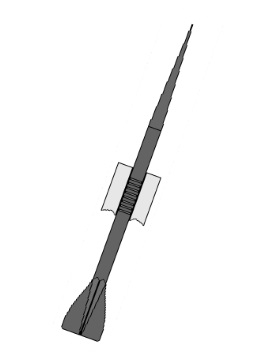 Flechettes are thin, razor-sharp projectiles typically fired from some kind of projectile weapon, more often than not, a rifle or handgun. They have been banned on most civilised worlds because of the horrific, disfiguring injuries they can cause and tend to be used by criminals and assassins.
Flechettes are thin, razor-sharp projectiles typically fired from some kind of projectile weapon, more often than not, a rifle or handgun. They have been banned on most civilised worlds because of the horrific, disfiguring injuries they can cause and tend to be used by criminals and assassins.
Cruise-Bombers
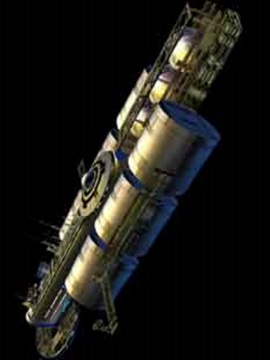 Cruise-bombers or CBs are small, manoeuvrable, virtually undetectable military space craft that primarily fires torpedoes and often "hunt" in packs. Originally envisaged as an orbital bomber, CBs became the space-warfare equivalent of the submarine. Slightly smaller than light-cruiser, they are usually built around a single coil gun designed to accelerate medium-heavy kinetics with a high degree of accuracy at stationary, slow moving or relatively predictable targets. They were used to devastating effect by the Akatsu and Geist in the Simerian-Lacuna and Abyssal Void wars respectively and led to the development of the Corvette or HK; fast, well-armed and lightly armoured specialist anti-cruise-bomber vessels.
Cruise-bombers or CBs are small, manoeuvrable, virtually undetectable military space craft that primarily fires torpedoes and often "hunt" in packs. Originally envisaged as an orbital bomber, CBs became the space-warfare equivalent of the submarine. Slightly smaller than light-cruiser, they are usually built around a single coil gun designed to accelerate medium-heavy kinetics with a high degree of accuracy at stationary, slow moving or relatively predictable targets. They were used to devastating effect by the Akatsu and Geist in the Simerian-Lacuna and Abyssal Void wars respectively and led to the development of the Corvette or HK; fast, well-armed and lightly armoured specialist anti-cruise-bomber vessels.
Mobile Infantry (UCS Marines)
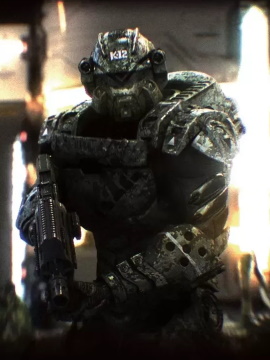 Marine MI is a multi-role force of mobile, mechanised infantry whose function is to attack specified targets, realise specific objectives, gain information and to cause disruption to enemy infrastructure. The majority of MI are drop troopers, frequently delivered from orbit by specialist vehicles, and might be considered the space warfare equivalent of twentieth to twenty-second-century paratroopers. The suit is the MI's key advantage offering the soldier enhanced protection, detection, strength, speed and agility on land, in the air, in space and under water. Later variants feature AI integration and better health monitoring.
Marine MI is a multi-role force of mobile, mechanised infantry whose function is to attack specified targets, realise specific objectives, gain information and to cause disruption to enemy infrastructure. The majority of MI are drop troopers, frequently delivered from orbit by specialist vehicles, and might be considered the space warfare equivalent of twentieth to twenty-second-century paratroopers. The suit is the MI's key advantage offering the soldier enhanced protection, detection, strength, speed and agility on land, in the air, in space and under water. Later variants feature AI integration and better health monitoring.
Akatsu Sakori B9F
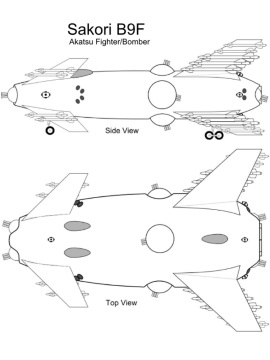 The Sakori B9F is a general purpose front-line manned fighter/bomber capable of both space & atmospheric combat and, in combination with the older Kashima D20, formed the main Akatsu fighter type for most of the Abyssal Void and Vishnu Conflicts. The second heaviest fighter/bomber fielded by the Akatsu, the B9F standard armament includes laser/kinetic turrets, forward facing kinetic and torpedo tubes as well as detachable mines. With facilities such as galley, shared bunks and toilets, the ship can fly for up to 72 hours on a single tour and the B9F is considered an excellent weapons platform with good defensive capabilities.
The Sakori B9F is a general purpose front-line manned fighter/bomber capable of both space & atmospheric combat and, in combination with the older Kashima D20, formed the main Akatsu fighter type for most of the Abyssal Void and Vishnu Conflicts. The second heaviest fighter/bomber fielded by the Akatsu, the B9F standard armament includes laser/kinetic turrets, forward facing kinetic and torpedo tubes as well as detachable mines. With facilities such as galley, shared bunks and toilets, the ship can fly for up to 72 hours on a single tour and the B9F is considered an excellent weapons platform with good defensive capabilities.
Akatsu Sakori M6Z
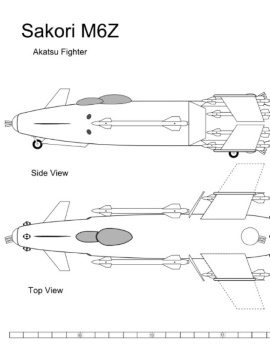 A general purpose front-line manned fighter capable of both space & atmospheric combat (requires different configurations), variations of this fighter forming the main Akatsu fighter type for most of the Abyssal Void and Vishnu Conflicts. With two defensive turrets, bottom and top, near the back of the craft the ship features 4 x 30mm forward-facing kinetics and 2 x 20mm rear-facing kinetics. In the hands of a good pilot, the M6Z can balance "on its tail", hovering over enemy targets, and using its ferocious main thrusters as weapons.
A general purpose front-line manned fighter capable of both space & atmospheric combat (requires different configurations), variations of this fighter forming the main Akatsu fighter type for most of the Abyssal Void and Vishnu Conflicts. With two defensive turrets, bottom and top, near the back of the craft the ship features 4 x 30mm forward-facing kinetics and 2 x 20mm rear-facing kinetics. In the hands of a good pilot, the M6Z can balance "on its tail", hovering over enemy targets, and using its ferocious main thrusters as weapons.
Akatsu Kashima D20
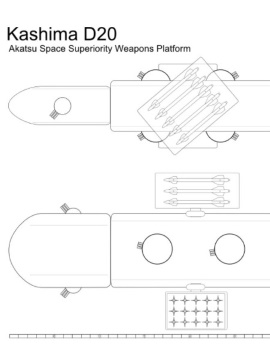 The Akatsu Kashima D20 is an older general-purpose manned fighter/bomber capable only of space combat which is still considered useful but requires fighter cover when in action against more modern ships. The D20 packs a much greater punch than the Sakori B9F and formed part of the main Akatsu fighter/bomber capability for most of the Abyssal Void War.
The Akatsu Kashima D20 is an older general-purpose manned fighter/bomber capable only of space combat which is still considered useful but requires fighter cover when in action against more modern ships. The D20 packs a much greater punch than the Sakori B9F and formed part of the main Akatsu fighter/bomber capability for most of the Abyssal Void War.
UCS Mk 3 Infantry Fighting Vehicle
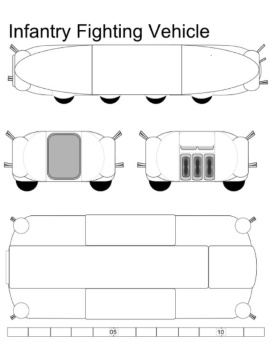 The UCS Mk 3 Infantry Fighting Vehicle is a modular, general purpose transport and fighting vehicle. An armoured low height truck-like vehicle available in two sizes that sits on six or eight globular, segmented "sphyres", the vehicle is a fast moving and versatile replacement for UCS main-battle tanks. With configurable central and side modules, it is an extremely flexible military vehicle and can be configured as a land-train or a lightly armoured tank. Whilst many nations still use battle tank variants and, although the IFV could not stand face to face with most conventional tanks, the IFV is nevertheless considered vastly more flexible.
The UCS Mk 3 Infantry Fighting Vehicle is a modular, general purpose transport and fighting vehicle. An armoured low height truck-like vehicle available in two sizes that sits on six or eight globular, segmented "sphyres", the vehicle is a fast moving and versatile replacement for UCS main-battle tanks. With configurable central and side modules, it is an extremely flexible military vehicle and can be configured as a land-train or a lightly armoured tank. Whilst many nations still use battle tank variants and, although the IFV could not stand face to face with most conventional tanks, the IFV is nevertheless considered vastly more flexible.
MIRV (Marine Insertion & Recovery Vehicle) M3C
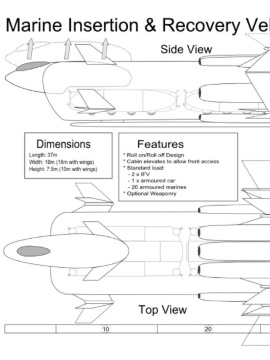 The Marine Insertion & Recovery Vehicle is an armoured shuttle designed to deliver marines and materials to a battle zone and extract them once the mission is complete. With 3 permanent crew, the MIRV is a fairly basic insertion vehicle with 6 deployable turrets and 4 surface mounted air-to-air missiles. Designed for stealth it has no active radar and relies on passive scanning for threat detection.
The Marine Insertion & Recovery Vehicle is an armoured shuttle designed to deliver marines and materials to a battle zone and extract them once the mission is complete. With 3 permanent crew, the MIRV is a fairly basic insertion vehicle with 6 deployable turrets and 4 surface mounted air-to-air missiles. Designed for stealth it has no active radar and relies on passive scanning for threat detection.
UCS Verithon OS Viper III
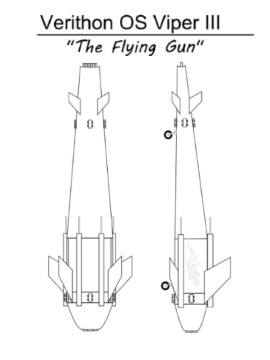 The Verithon OS Viper III is a single-person fighter that is both space and atmosphere capable. Nicknamed "The Firefly", it is currently in main service across the entire UCS and Skean arenas.
The Verithon OS Viper III is a single-person fighter that is both space and atmosphere capable. Nicknamed "The Firefly", it is currently in main service across the entire UCS and Skean arenas.
UCS MSS Python V2B
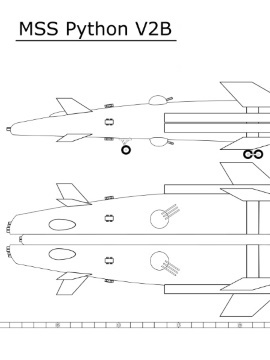 A general purpose, three-person high-performance atmosphere capable space fighter/bomber (atmospheric combat requires the use of optional wings). The V2B has now been retired in favour of the V2C/D which form part of main attack capability of the UCS and Skean for most of the Abyssal Void and Vishnu conflicts.
A general purpose, three-person high-performance atmosphere capable space fighter/bomber (atmospheric combat requires the use of optional wings). The V2B has now been retired in favour of the V2C/D which form part of main attack capability of the UCS and Skean for most of the Abyssal Void and Vishnu conflicts.
UCS MSS Python V2C/D
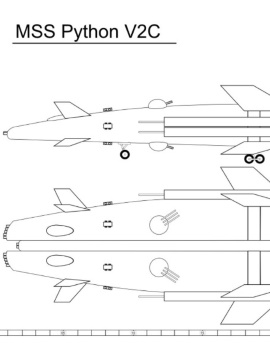 General purpose, two-person high-performance atmosphere capable space fighter/bomber (atmospheric combat requires the deployment of internal wings). Built slightly pre-war a flight of these arrived during the second wave of the Port McKinley attack but were quickly protected with 2 destroyed, 3 damaged and 15 remaining. The V2C and the slightly more recent D variant form part of main attack capability of the UCS and Skean for most of the Abyssal Void and Vishnu conflicts.
General purpose, two-person high-performance atmosphere capable space fighter/bomber (atmospheric combat requires the deployment of internal wings). Built slightly pre-war a flight of these arrived during the second wave of the Port McKinley attack but were quickly protected with 2 destroyed, 3 damaged and 15 remaining. The V2C and the slightly more recent D variant form part of main attack capability of the UCS and Skean for most of the Abyssal Void and Vishnu conflicts.
UCS MSS Cobra F117A
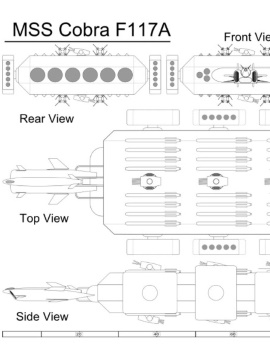 The MSS Cobra F117A is a modern AI/human space superiority platform capable only of space combat. There were only 27 in service at the start of the Abyssal Void War but the bomber became one of the mainstays of the UCS mobile heavy strike capability for the rest of the war being replaced/replenished later by the upgraded models, F117B and F118A. With UCS permission, MSS leased 24 ships to the Skean for use against the Geist and Akatsu.
The MSS Cobra F117A is a modern AI/human space superiority platform capable only of space combat. There were only 27 in service at the start of the Abyssal Void War but the bomber became one of the mainstays of the UCS mobile heavy strike capability for the rest of the war being replaced/replenished later by the upgraded models, F117B and F118A. With UCS permission, MSS leased 24 ships to the Skean for use against the Geist and Akatsu.

Quotes
!If you can tell stories, create characters, devise incidents, and have sincerity and passion, it doesn't matter a damn how you write."
!If you can tell stories, create characters, devise incidents, and have sincerity and passion, it doesn't matter a damn how you write."

